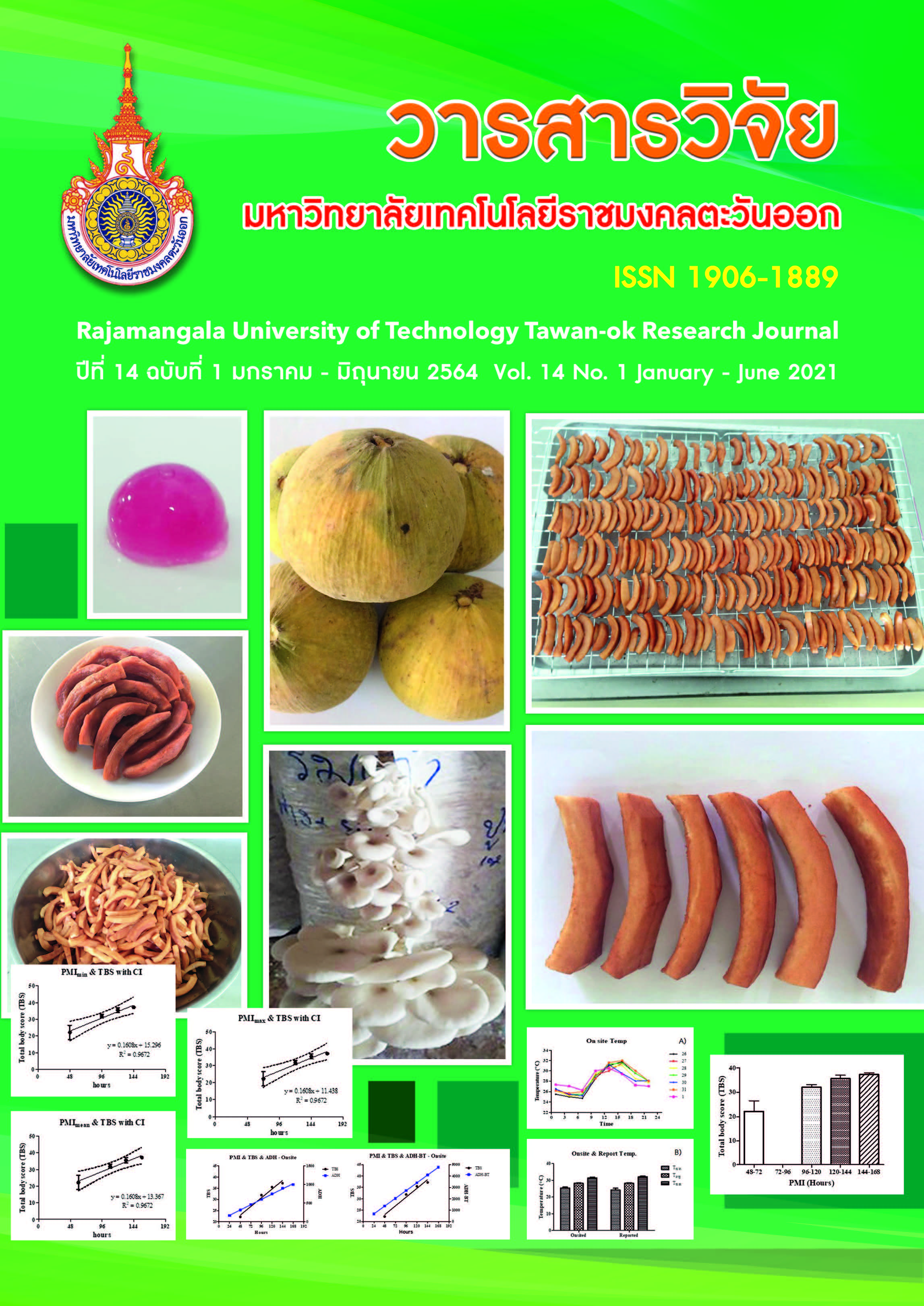Producing Bubble Dragon Fruit Peel with Pineapple Juice Using Reverse Spherification Technique
Main Article Content
Abstract
The purpose of this research was to study the production of bubble dragon fruit peel juice with pine apple juice by reverse spherification technique. The levels of pineapple juice added into bubble dragon fruit peel juice were 0% (control), 10%, 20%, 30% and 40% by weight of peel dragon juice. Bubble dragon fruit peel juice with pineapple juice was developed using reverse spherification technique. For the development of bubble dragon fruit peel juice with pineapple juice, concentrations 1.5% of calcium lactate, and 0.5% of sodium alginate were used in this research. The result showed that the most panelists accepted the bubble dragon fruit peel juice with 20% of pineapple juice. Bubble dragon fruit peel juice with 40% of pineapple juice was low pH (pH = 3.83) and high citric acid (0.43%). The level of pineapple juice added into bubble dragon fruit peel affected the color and hardness of the product but did not statistically significant influence the size of bubble dragon fruit peel juice (p > 0.05). The acid level of pineapple juice may affect the internal structure of bubble dragon fruit peel, resulting in a decrease of hardness.
Article Details
References
Chien, P.J.; Sheu, F. & Lin, H.R. 2007. Quality assessment of low molecular weight chitosan coating on sliced red pitayas. Food Engineering, 79: 736-740.
Dholvitayakhun, A. & Pumpho, P. 2018. Mock pomegranate seeds dessert (Tab Tim Grob) production using frozen reverse spherification technique. Food Technology, Siam University, 13(2), 49-59.
Lichanporn. I., Nanthachai. N., Tangnurat. P., & Singkhum, U. 2017. Development of gummy candies from dragon fruit peel. In Proceeding of 5th academic science and technology conference. (pp.403-408). Thailand: Bangkok.
Lichanporn. I., Nanthachai. N., Tangnurat. P. & Singkhum, U. 2018. Effect of dragon fruit extract on physico chemical and sensory characteristics of ready-to-drink beverage. In Proceeding of 5th academic science and technology conference. (pp. 393-399). Thailand: Bangkok.
Kamprawet, P. & Vatthanakul, S. (2018). Producing Passion Fruit Beads by Reverse Spherification Technique. Science and Technology, 26(8), 1381-1393.
Matan, N., Puangjinda, K., Phothisuwan, S., & Nisoa, M. 2015. Combined antibacterial activity of green tea extract with atmospheric radio-frequency plasma against pathogens on fresh-cut dragon fruit. Food Control. 50, 291–296.
Muangrat. R., Sakulkaipeera, K., Burakhum. T. & Chomnan, L. 2014. Factors affecting extraction of anthocyanins from purple corn. Science and Technology, 22(3), 367-380.
Nerd, A. & Mizrahi, Y. (1999). The effect of ripening stage on fruit quality after storage of yellow pitaya. Postharvest Biology and Technology, 15, 99-105.
Pawar, S.N. & Edgar, K.J. 2012. Alginate derivatization: A review of chemistry properties and applications. Biomaterials, 33(11), 3279-3305.
Pichayajittipong, P. 2013. Production and biologicail properties of food colorants from red dragon fruit (Hylocercus polyshizus) Peels. M.S. thesis, Food Technology, Suranaree University of Technology, Thailand.
Pumpho, W. & Puechkamutr, Y. 2015. Tofu-ball production from spherification technique using sodium alginate. In Proceedings of 53rd Kasetsart University Annual Conference: Science, Genetic Engineering, Architecture and Engineering, Agro-Industry, Natural Resources and Environment. (pp. 1050-1057), Thailand: Bangkok.
Vargas, M., Cortez, J., Duch, E., Lizama, A. & Méndez, C. 2013. Extraction and stability of anthocyanins present in the skin of the dragon fruit (hylocereus undatus). Food and Nutrition Sciences, 4(12), 1221-1228.


